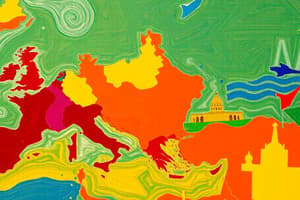Podcast
Questions and Answers
Rome's first period of expansion lasted for more than ______ years.
Rome's first period of expansion lasted for more than ______ years.
200
The last Etruscan king was overthrown in ______ B.C.E.
The last Etruscan king was overthrown in ______ B.C.E.
509
In 493 B.C.E., Roman leaders signed a treaty with their ______ neighbors.
In 493 B.C.E., Roman leaders signed a treaty with their ______ neighbors.
Latin
In 390 B.C.E., a band of ______ crushed a Roman army and invaded the city.
In 390 B.C.E., a band of ______ crushed a Roman army and invaded the city.
After the Gauls invaded, the Romans decided to ______ their city.
After the Gauls invaded, the Romans decided to ______ their city.
During the 300s B.C.E., Rome conquered the ______ and many neighboring tribes.
During the 300s B.C.E., Rome conquered the ______ and many neighboring tribes.
Rome battled a people called the ______ to the south.
Rome battled a people called the ______ to the south.
By 275 B.C.E., Rome's conquest of the Italian ______ was complete.
By 275 B.C.E., Rome's conquest of the Italian ______ was complete.
Many soldiers in the Roman army were ______ who resented their service.
Many soldiers in the Roman army were ______ who resented their service.
By 264 B.C.E., Rome had more citizens and well-trained ______ than any other power.
By 264 B.C.E., Rome had more citizens and well-trained ______ than any other power.
Study Notes
Roman Expansion in the Italian Peninsula (509 B.C.E. - 264 B.C.E.)
- Rome's initial period of territorial expansion lasted over 200 years and involved continual warfare.
- Expansion began sharply after the overthrow of the last Etruscan king in 509 B.C.E.
- A significant treaty was formed in 493 B.C.E. with Latin neighbors, promising peace and cooperative defense against enemies.
Military Engagements and Challenges
- Throughout the next century, Rome fought numerous wars against Etruscans and local tribes.
- In 390 B.C.E., a pivotal moment occurred when Gauls invaded, defeated a Roman army, and devastated the city of Rome.
- After the destruction, Romans chose to rebuild and fortify their city instead of abandoning it.
Conquests and Conflicts
- In the 300s B.C.E., Rome successfully conquered the Etruscans and waged wars against the Samnites and Greek city-states.
- By 275 B.C.E., Rome had completed its conquest of the entire Italian peninsula.
Costs of Expansion
- Two centuries of warfare took a toll on Rome's populace and resources.
- The Gauls' attack was a stark reminder of the fragility of Roman power, intensifying the need for a strong military.
- Expansion mandated a large, permanent army, leading to increased military service obligations for Roman citizens, especially plebeians, causing civil unrest.
Citizenship and Treatment of Conquered Peoples
- Rome offered citizenship to some defeated city inhabitants, while others received limited privileges such as trade rights.
- Roman allies bore the burden of paying taxes and providing soldiers to serve in Roman armies.
Roman Military Strength
- By 264 B.C.E., Rome had the largest number of citizens and well-trained soldiers compared to any Mediterranean power, setting the stage for future conflicts.
Studying That Suits You
Use AI to generate personalized quizzes and flashcards to suit your learning preferences.
Description
Explore the early years of Roman territorial expansion, highlighting key military engagements, significant treaties, and the challenges faced during conflicts with Etruscans, Gauls, and local tribes. This quiz covers the monumental shifts that occurred from 509 B.C.E. to 264 B.C.E. as Rome sought to dominate the Italian peninsula.




